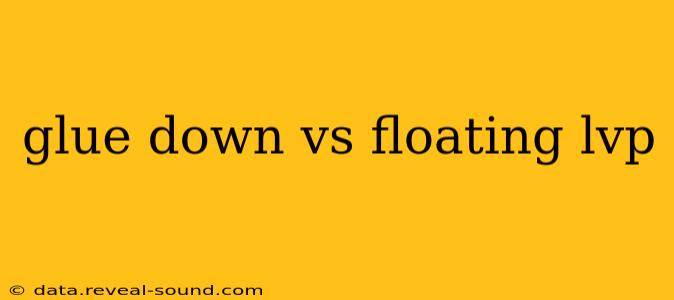Choosing between glue-down and floating luxury vinyl plank (LVP) flooring can feel overwhelming. Both offer beautiful, durable options, but their installation methods and resulting characteristics differ significantly. This comprehensive guide will help you understand the pros and cons of each to make the best choice for your home.
What is Glue-Down LVP?
Glue-down LVP involves adhering each plank directly to the subfloor using a specialized adhesive. This creates a rigid, permanent bond. Think of it like tiling, but with the ease of working with LVP planks.
Advantages of Glue-Down LVP:
- Superior Durability and Stability: Glue-down LVP offers exceptional stability, resisting dents, scratches, and shifting over time. The rigid bond prevents movement and warping, especially beneficial in high-traffic areas.
- Water Resistance: While all LVP is water-resistant to some degree, glue-down installation further enhances this protection by sealing the planks to the subfloor, minimizing the risk of water damage.
- Quietness: The secure bond reduces sound transmission, creating a quieter living space compared to floating floors.
- Seamless Appearance: Glue-down installations often result in a more seamless, unified look with fewer visible seams.
Disadvantages of Glue-Down LVP:
- Difficult Installation: Glue-down requires more skill and precision than floating LVP. Proper subfloor preparation is crucial, and using the correct adhesive is essential for a successful installation. Mistakes can be costly to rectify.
- Permanent Installation: Removing glue-down LVP is far more challenging and labor-intensive than removing floating LVP, making it a less flexible choice if you plan on replacing the flooring in the future.
- Longer Installation Time: The gluing and drying time significantly extend the overall installation process compared to floating options.
What is Floating LVP?
Floating LVP, also known as click-lock LVP, utilizes a click-lock system where planks interlock without adhesive. The entire floor "floats" on top of the subfloor.
Advantages of Floating LVP:
- Easy Installation: Floating LVP is significantly easier to install, making it a DIY-friendly option. The click-lock system is relatively straightforward, even for beginners.
- Quick Installation Time: The absence of drying time allows for much faster installation compared to glue-down.
- Removable and Reusable (Potentially): Floating LVP can be removed and, in some cases, reused in a different location, offering greater flexibility.
- Subfloor Imperfection Tolerance: Floating LVP is more forgiving of minor subfloor imperfections, as the click-lock system helps to accommodate some irregularities.
Disadvantages of Floating LVP:
- Less Durable: Floating LVP is generally less durable than glue-down, potentially showing more dents, scratches, and wear in high-traffic areas.
- Potential for Movement: The floating nature can lead to slight creaking or shifting over time, particularly in areas with significant temperature or humidity fluctuations.
- Less Water Resistance: While still water-resistant, floating LVP is generally less resistant to water damage than glue-down due to the gaps between planks.
- More Pronounced Seams: The seams between planks are generally more visible in floating installations.
Which Type of LVP is Right for You?
The best choice depends on your specific needs and priorities:
- Choose glue-down LVP if: You prioritize durability, water resistance, a seamless look, and sound reduction. You’re willing to invest in professional installation or have significant DIY experience.
- Choose floating LVP if: You prioritize ease of installation, cost-effectiveness, and the ability to remove the flooring later. You are comfortable with the potential for less durability and slightly more visible seams.
What is the best underlayment for LVP?
The ideal underlayment depends on the type of LVP (glue-down or floating) and your specific needs. For floating LVP, a high-quality underlayment is crucial to provide cushioning, sound insulation, and moisture protection. Glue-down LVP generally requires a different, thinner underlayment or might not require one at all depending on the subfloor condition. Always consult the manufacturer's instructions for recommendations.
How long does LVP flooring last?
The lifespan of LVP flooring depends on several factors, including the quality of the product, installation method, and level of traffic. Generally, LVP can last for 15-25 years or more with proper care and maintenance, regardless of whether it's glue-down or floating.
Is LVP easy to install?
The ease of installation depends on the type. Floating LVP is generally considered easier to install than glue-down LVP, making it a more DIY-friendly option. Glue-down requires more expertise and precision.
Can you install LVP over existing tile?
Installing LVP directly over existing tile is generally not recommended. The existing tile might not provide a level and stable surface, leading to issues with the LVP installation. Consider removing the existing tile before installing LVP for optimal results. However, some manufacturers offer solutions for specific tile types and conditions. Consult with a flooring professional to assess the feasibility.
This guide provides a comprehensive overview of glue-down versus floating LVP. Remember to consult with flooring professionals for personalized advice and to ensure a successful installation tailored to your specific needs and circumstances.
